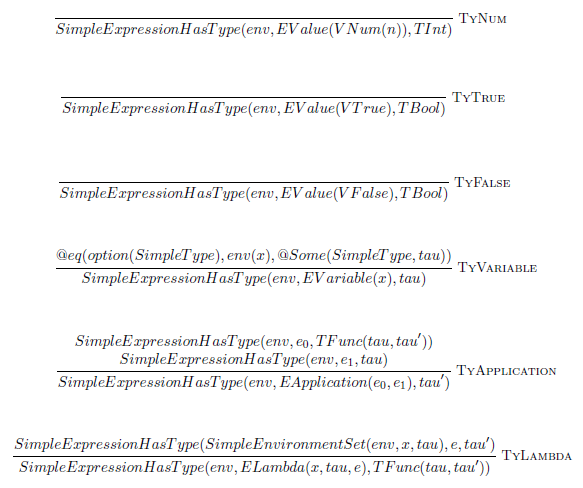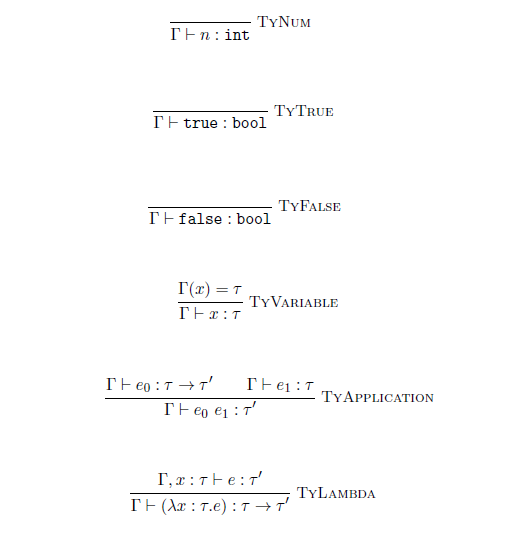tl;wr - clone repo, goto
examples, launchsimplyTyped.[sh/bat], see how it works, adjust to your satisfaction
A simple tool to auto-generate LaTeX inference rules from inductive propositions in your Coq file.

- You're working on a paper/thesis/presentation/... and are sick of doing the same work twice
- Like your fellow humans, you tend to misspell variable names every once in a while. Coq will complain, LaTeX won't.
- You adjusted some rules and are now getting a headache finding the corresponding spots in that LaTeX-spaghetti code.
- Or you just hate writing LaTeX.
...of the example you can find at examples/simplyTyped.
Inductive SimpleExpressionHasType : SimpleEnvironment -> SimpleExpression -> SimpleType -> Prop :=
| TyNum : forall n env, SimpleExpressionHasType env (EValue (VNum n)) TInt
| TyTrue : forall env, SimpleExpressionHasType env (EValue VTrue) TBool
| TyFalse : forall env, SimpleExpressionHasType env (EValue VFalse) TBool
| TyVariable : forall env tau x,
env x = Some tau ->
SimpleExpressionHasType env (EVariable x) tau
| TyApplication : forall env e_0 e_1 tau tau',
SimpleExpressionHasType env e_0 (TFunc tau tau') ->
SimpleExpressionHasType env e_1 tau ->
SimpleExpressionHasType env (EApplication e_0 e_1) tau'
| TyLambda : forall env x e tau tau',
SimpleExpressionHasType (SimpleEnvironmentSet env x tau) e tau' ->
SimpleExpressionHasType env (ELambda x tau e) (TFunc tau tau')
.Run
<tool> <coq-file (without .v extension)> <name of inductive proposition>
from the directory containing the coq-file. In the above example, this would be
<tool> simplyTyped SimpleExpressionHasType
LaTeX should be thrown at you (meant to be redirected to a tex-file).
If not, make sure that coqtop is in your path (or modify coq2latex.[sh/bat] so it uses the absolute path) and that the coq2latex binary is compiled and found.
What it should look like:
But wait, that looks horrible!
Indeed!
Reason: coq2latex won't guess what an ELambda, env, TInt or SimpleExpressionHasType is supposed to look like.
Instead, it assumes that everything is a predicate/function and renders it accordingly (this is a nice fallback as we will see later).
Let's fix that.
(*coq2latex: SimpleExpressionHasType #G #e #t := #G \vdash #e : #t *)
Inductive SimpleExpressionHasType : SimpleEnvironment -> SimpleExpression -> SimpleType -> Prop :=
| TyNum : forall n env(*\Gamma*), SimpleExpressionHasType env (EValue (VNum n)) TInt
| TyTrue : forall env(*\Gamma*), SimpleExpressionHasType env (EValue VTrue) TBool
| TyFalse : forall env(*\Gamma*), SimpleExpressionHasType env (EValue VFalse) TBool
| TyVariable : forall env(*\Gamma*) tau(*\*) x,
env x = Some tau ->
SimpleExpressionHasType env (EVariable x) tau
| TyApplication : forall env(*\Gamma*) e_0 e_1 tau(*\*) tau'(*\*),
SimpleExpressionHasType env e_0 (TFunc tau(*\*) tau'(*\*)) ->
SimpleExpressionHasType env e_1 tau ->
SimpleExpressionHasType env (EApplication e_0 e_1) tau'
| TyLambda : forall env(*\Gamma*) x e tau(*\*) tau'(*\*),
SimpleExpressionHasType (SimpleEnvironmentSet env x tau) e tau' ->
SimpleExpressionHasType env (ELambda x tau e) (TFunc tau tau')
.There are two kinds of translation hint you can provide (see below for more detailed documentation):
-
rewrite rules for relations:
(* coq2latex: <relation name> <parameters> := <LaTeX pattern> *) -
alternative names for bound variables:
<original variable name>(*<LaTeX alternative>*)- giving just
\as the LaTeX alternative will simply treat the variable name as a LaTeX command, seetau(*\*)
- giving just
Until it looks something like this:
Note that in rule TyVariable it is still the "fallback" that renders env x as \Gamma(x).
Each parameter is either
- a variable
#<some name>(that matches anything and can be used in the LaTeX pattern) or - a Coq expression (that must be matched in order for the rewrite rule to apply)
- Example:

